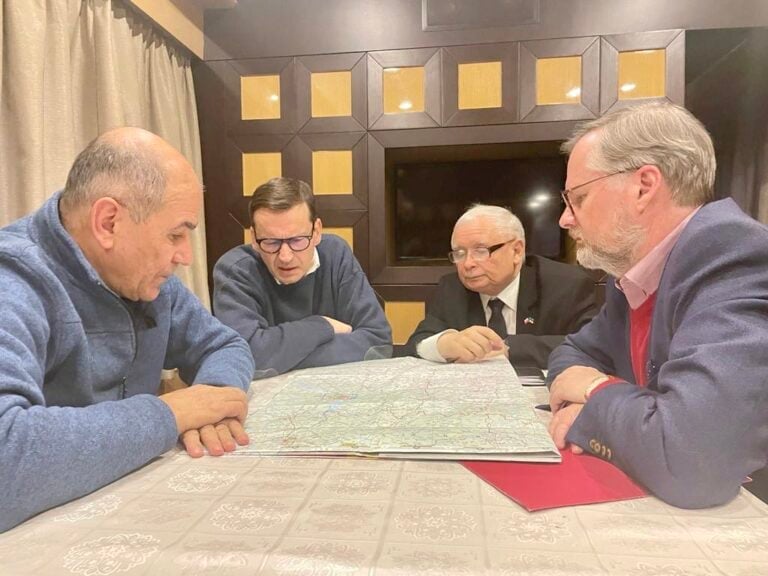“It is fascinating that a European political delegation, in order to prove to the Ukrainian people that they are not alone in these difficult times, should directly visit a city that has literally turned into a battlefield,” Slovenian MEP Dr Milan Zver wrote a year ago. Former NATO Commander, USA General Wesley K. Clark, described the visit to CNN as remarkable, even comparing it to a visit to London during the Second World War. Janez Janša was among the first to make the trip to Kyiv, just three weeks after the Russian invasion of Ukraine.
A year has already passed since the then-Prime Minister of the Republic of Slovenia, Janez Janša, the Prime Minister of Poland, Mateusz Morawiecki, the Prime Minister of the Czech Republic, Petr Fiala, and the Deputy Prime Minister of Poland and Chairman of the Polish Committee on National Security and Defence, Jaroslaw Kaczyński, travelled to Ukraine as representatives of the European Council, to meet with the Ukrainian President, Volodymyr Zelensky, and the Ukrainian Prime Minister, Denis Shmyhal. The visit is still etched in the hearts of Ukrainians today, and they recently paid tribute to the quarter with a public acknowledgement in public places: “We remember. The 15th of March 2022. First visit of foreign leaders to Kyiv.”
“This is something that you remember for a lifetime,” the Slovenian Democratic Party (Slovenska demokratska stranka – SDS) President said recently, admitting that the journey or the visit itself was not the most arduous thing, but it was much more arduous to convince his colleagues that it was necessary to go to Ukraine. At the Versailles meeting, he addressed his European colleagues and also justified the visit with the Slovenian example – we invited many foreign statesmen to our country at the time when we were fighting for our independence, but hardly anyone came out of fear – but at that time, the vast majority did not believe that Ukraine would manage to endure the attacks. Today, we see that the decision was the right one, because the Ukrainian President decided to stay in his country, and Ukraine has not fallen to this day.
Today, those who criticised the courageous move at the time also see that going to Kyiv was the right decision. After inappropriately criticising Janša’s visit to Kyiv, which was, in fact, a sign of solidarity and courage, current Foreign Minister Tanja Fajon visited Kyiv herself five months later. However, she noted that she herself had visited Kyiv in a better security situation and that five months ago, it was not the right time for “solo actions”. Fajon’s visit to Kyiv was, in fact, a complete reversal of her previous policy, but let us leave it at that.
Janša’s example was followed by many other statesmen – just before the anniversary of the Russian attack on Ukraine, the USA President Joe Biden visited Kyiv, preceded by French President Emmanuel Macron, Italian Prime Minister Mario Draghi, German Chancellor Olaf Scholz and Romanian President Klaus Iohannis. British Prime Minister Boris Johnson, Canadian Prime Minister Justin Trudeau, and a number of others have also already visited Ukraine – this year, for example, it was Italian Prime Minister Giorgia Meloni and Spanish Prime Minister Pedro Sanchez. As the airspace over Ukraine remains closed, all visitors arrive in Kyiv by train. According to some media reports, Slovenian Prime Minister Robert Golob is also leaving for Kyiv in mid-April.
For their bravery and sincere support in the darkest moments of the Ukrainian nation, the first visitors to Kyiv were rewarded with a special plaque immortalising their names for future Ukrainian generations. As mentioned above, a billboard campaign has also been launched in central Kyiv to express gratitude to the Prime Ministers of Poland, the Czech Republic and Slovenia for making the dangerous trip to Kyiv on the 15th of March 2022. “They were the first leaders to visit Kyiv,” the Visegrad24 Twitter account pointed out, congratulating the brave leaders.
Sara Kovač


